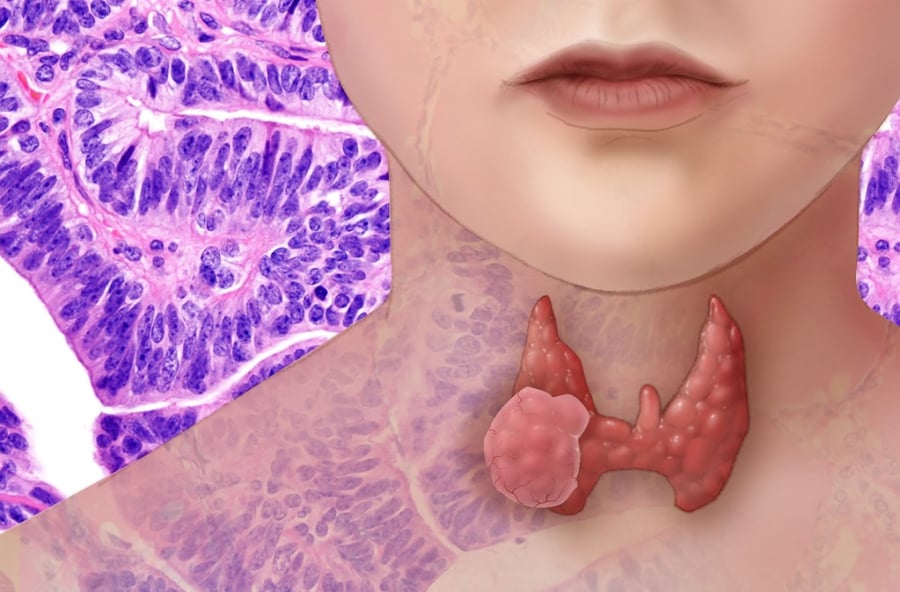A woman who suspected she had swollen lymph nodes was diagnosed with papillary thyroid carcinoma
Some people with swollen lymph nodes in their necks often assume it is a common lymphadenitis and don’t pay attention. However, one patient, upon examination, discovered a thyroid mass.
Tam Anh General Hospital in Ho Chi Minh City reported that Ms. Hien had noticed a neck mass about a month earlier. At first, she thought it was a benign lymphadenitis that would go away in a few days. Two weeks later, the mass grew larger, and when pressed, it caused pain, so she went to the hospital for an examination.
On March 19, M.Sc. M.B.B.S. CKI Phan Vu Hong Hai of the Department of Thoracic and Vascular Surgery, shared the results of Ms. Hien’s ultrasound, which revealed a multi-nodular goiter with benign thyroid nodules, TIRADS 2 grading. Among these, there was a 3 cm nodule with suspected internal hemorrhage, causing pain.
Separately, in the isthmus region of the thyroid (the area just in front of the neck, at the back of the thyroid, above the trachea, and below the larynx), there was a 14×9 mm nodule, graded as TIRADS 3. TIRADS is a classification system for thyroid lesions that helps assess the risk of malignancy in thyroid masses. TIRADS 1-3 are considered benign, TIRADS 4 suggests malignancy, and TIRADS 5-6 indicate a high risk of malignancy.
According to Dr. Hai, in Ms. Hien’s case, it was highly likely to be a benign thyroid nodule, and only a nodule resection was required. In some cases, small nodules may not need to be removed. However, some nodules displayed characteristics that raised suspicion of malignancy, such as solid composition and calcification. Therefore, the doctor decided to perform a surgical resection of one thyroid lobe and a partial resection of the remaining lobe to eliminate the nodules and reduce the risk of nodule recurrence.

The surgery, lasting over two hours, involved Dr. Hai and his team carefully dissecting the thyroid areas containing the nodules and resecting the isthmic nodule while preserving the nerves and blood vessels. Postoperatively, the patient recovered quickly without complications such as hoarseness or hand and foot numbness. She was discharged two days later.
Pathological examination results after one week revealed a multifocal goiter with adhesive nodules ranging from 0.5 cm to 3 cm. Notably, one tiny nodule, measuring only 3 mm, was diagnosed as papillary thyroid carcinoma with a cystic variant in the early stage.
According to Dr. Hai, the diagnosis of papillary thyroid carcinoma with a cystic variant underscores the importance of postoperative pathological evaluation, even when preoperative imaging does not strongly indicate malignancy. Surgery allows for the removal of malignant lesions while preserving a portion of the thyroid gland, thus preventing complications arising from complete thyroidectomy.
In this case, the patient’s prognosis is very favorable, especially with no evidence of metastasis or invasion. However, regular follow-up is necessary to detect any early signs of recurrence or the development of new lesions in the remaining thyroid tissue.
What can be done to prevent thyroid cancer?
M.Sc. M.B.B.S. CKI Le Thi Ngoc Hang, from the Department of Thoracic and Vascular Surgery at Tam Anh General Hospital in Ho Chi Minh City, explained that thyroid cancer arises from malignant tumors in the thyroid region. It is classified into four types: papillary, follicular, medullary, and anaplastic thyroid cancer. Ms. Hien was diagnosed with papillary thyroid carcinoma with a cystic variant, which carries a good prognosis. With aggressive treatment, the five-year survival rate exceeds 98%.
Thyroid cancer in its early stages often exhibits subtle or no symptoms. However, attentive individuals may notice signs such as lumps in the neck, difficulty swallowing, neck pain, a feeling of fullness in the throat, hoarseness, or weight loss.
If you notice any of these signs, seek immediate medical attention, as early intervention is crucial. Thyroid disorders can have a genetic component, so if you have a family history of thyroid disease, consider proactive screening.































